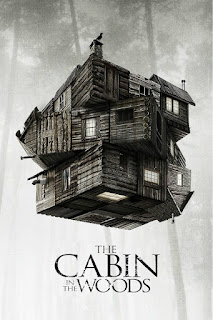Film - Cabin in the Woods
So, this a horror movie, right? So we know exactly what's going to happen - of course we do.
The Cabin in the Woods comes across like a 'by the numbers, paint my First American Horror Movie' - the major players fit the classic Kitsch horror-movie archetypes: Dana (Kristen Connolly) the virginal good girl; Jules (Anna Hutchison) the party girl of easy virtue (who, it is pointed out, has just dyed her hair blonde, to emphasise the fact) Curt (Chris Hemsworth) the jock/stud; Holden (Jesse Williams) the brainy one and Marty (Fran Kranz) the goofy-stoner-comic relief. So far, so textbook. In the first 20 minutes, you seem to have group of young adults who come as close to a 'Scooby-Doo' -type team as possible, without being drawn as cartoons. Soon we'll get the hot girl-next-door coed in her underwear and the scrofulous backwoods filling-station owner who speaks in ominous and cryptic warnings. Yep, we can check those off the list.
But The Cabin in the Woods is a movie written by Joss Whedon with director Drew Goddard and, judging from their previous outings, these two revel in toying with audience expectation. They love to manipulate archetypes and to chew up genres - spitting them back out again in a new, irreverent, crowd-hoodwinking configuration. The movie poster - the cabin twisting in sections like a Rubik's Cube, might have given us a clue. True to form, Cabin takes bits and pieces from here and there, stuffs them in their mental liquidizer, and blends them into a vivid entertainment spectacle.
The movie turns out to be an affectionately satirical nightmare-scenario that asks us why, in a comparatively civilized society, is the horror genre is still so potent: what unhealthy subconscious human need is being fed by seeing attractive young people in states of undress suddenly, brutally slaughtered? Why does the genre adhere so closely to the belief that certain kinds of people seen to be behaving carelessly, must be put in jeopardy and then be picked off one by one, leaving a single, most worthy character, who had initially appeared to be vulnerable, but in whom the situation has revealed reserves of courage and endurance? Could there be some anthropological basis to this ritualistic behaviour in the horror genre?
All this stereotyping and speculation may hinder viewers from investing in the characters: but we are, after all, watching an artifice, a movie, a fact we’re never allowed to forget. Doubly so, as we are watching a movie about watching an artificially constructed place - this is no ordinary cabin in the woods, but actually a set for a diabolical ritual or experiment. Beneath the cabin is a basement, and beneath that is a vast modern laboratory headed by technology geeks (Richard Jenkins and Bradley Whitford) who turn dials, flick switches and monitor every second on a bank of TV monitors, watching their effects. The scheme is to offer their five young lab-rats a series of choices, which will reveal - who knows precisely what. Jenkins and Whitford are excellent as the cynical, sarcastic mid-level government cogs, and their script zips along quite amusingly. It becomes apparent that this is a movie about which Whedon and Goddard have their tongues planted firmly in their cheeks.
In some sense, the Jenkins and Whitford characters represent Whedon and Goddard, who reverse-engineer every cliché with glee, serving up the movie within the style of gratuitous violence and horror movie 'rules' but subsequently flipping them on their heads. So, their young protagonists sadistic, formulaic victimisation is part of a larger picture, one whose audience they semi-seriously reprove for the cynicism and cruelty with which they view the spectacle.
The action culminates in a sensational, surreal scene in which pretty much all horrible things ever imagined meet in an over-the-top encounter not only with each other but with those whose job it is has been to keep them under control – a sequence which seems to give a nod to the 'elevator' scene in The Shining. If you're a horror fan you'll enjoy spotting all the movies that are referenced (Hellraiser, The Creature From The Black Lagoon, The Evil Dead, The Strangers) and the horror sub-genres that are briefly acknowledged: (torture porn, zombies, werewolves, monster movies, the mythic beasts of H.P. Lovecraft and my personal favourite- Japansese horror).
The Cabin in the Woods is a shrewd, sideways look at the programmatic conventions of the horror genre, a satire that is also a re-examination. It's in the vein of 'Buffy'- self-referential, full of pop-culture references, with a knowing wink at everyone's nightmares. Does it scare us? Sometimes, but in this case, that's not the point. The point is, it's a game for horror fans to engage in.
Image - IMDb.
Image - IMDb.






Post a Comment